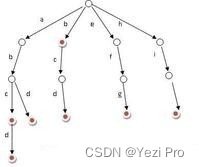用Java实现字典
用Java实现字典
提问于 2011-01-02 10:03:20
任务字典ADT
字典ADT用相同的键建立可搜索的密钥元素entries
- Multiple项的集合是allowed
- Applications:字定义对
。
字典ADT方法:
查找(K):如果字典中有一个键为k的条目,则返回它,否则,返回null
- findAll(k):返回所有条目的迭代器,其中包含键k
- insert(k,o):插入并返回条目(k,o)
- remove(e):从dictionary
- size(),isEmpty()
中删除条目e)
操作输出字典
insert(5,A) (5,A) (5,A)
insert(7,B) (7,B) (5,A),(7,B)
insert(2,C) (2,C) (5,A),(7,B),(2,C)
insert(8,D) (8,D) (5,A),(7,B),(2,C),(8,D)
insert(2,E) (2,E) (5,A),(7,B),(2,C),(8,D),(2,E)
find(7) (7,B) (5,A),(7,B),(2,C),(8,D),(2,E)
find(4) null (5,A),(7,B),(2,C),(8,D),(2,E)
find(2) (2,C) (5,A),(7,B),(2,C),(8,D),(2,E)
findAll(2) (2,C),(2,E) (5,A),(7,B),(2,C),(8,D),(2,E)
size() 5 (5,A),(7,B),(2,C),(8,D),(2,E)
remove(find(5)) (5,A) (7,B),(2,C),(8,D),(2,E)
find(5) null (7,B),(2,C),(8,D),(2,E)详细解释:否
回答 2
Stack Overflow用户
发布于 2011-01-02 10:07:44
Java已经有了一个集合,它几乎满足了您的所有需要。你只需要添加一种方法。首先,探索java.util.Collection..。类。然后扩展一个以添加所需的方法。如果做得好,这只是几十条线的问题。
对我来说,最简单的方法是使用Map<Object, Set<Object>>。最棘手的是返回一个迭代器。
编辑:
另一方面,我会用这个Entry.java
public class Entry<K, V> {
K key;
V value;
public Entry(K key, V value) {
this.key = key;
this.value = value;
}
public K key() {
return key;
}
public V value() {
return value;
}
@Override
public String toString() {
return "(" + key + ", " + value + ")";
}
// Methods needed to correctly behave in containers like sets, hashmaps:
// (I generated those automatically in NetBeans)
@Override
public boolean equals(Object obj) {
if (obj == null)
return false;
if (getClass() != obj.getClass())
return false;
final Entry<K, V> other = (Entry<K, V>) obj;
if (this.key != other.key && (this.key == null || !this.key.equals(other.key)))
return false;
if (this.value != other.value && (this.value == null || !this.value.equals(other.value)))
return false;
return true;
}
@Override
public int hashCode() {
int hash = 7;
hash = 23 * hash + (this.key != null ? this.key.hashCode() : 0);
hash = 23 * hash + (this.value != null ? this.value.hashCode() : 0);
return hash;
}
}..。也是这样的:Dictionary.java
import java.util.Iterator;
import java.util.LinkedList;
import java.util.List;
public class Dictionary<K, V> {
private List<Entry<K, V>> set;
public Dictionary() {
this.set = new LinkedList<Entry<K, V>>();
}
/**
* find(k): if the dictionary has an entry with key k, returns it, else, returns null
*/
public Entry<K, V> find(K key) {
// for all entries in set...
// check if key mathches
// - if it does than return it
// else
return null;
}
/**
* findAll(k): returns an iterator of all entries with key k
* @return
*/
public Iterator<Entry<K, V>> findAll(K key) {
// make a temporary list
// for all entries in set...
// check if key matches
// - if it does than add it to temporary list
// return the temporary list iterator (list.iterator())
return null;
}
/**
* insert(k, o): inserts and returns the entry (k, o)
*/
public Entry<K, V> insert(K key, V value) {
// obvious
return null;
}
/**
* remove(e): remove the entry e from the dictionary
*/
public Entry<K, V> remove(Entry<K, V> entry) {
return entry;
}
public int size() {
return set.size();
}
public boolean isEmpty() {
return size() == 0;
}
@Override
public String toString() {
return set.toString();
}
}.和这个DictionaryTest.java
public class DictionaryTest {
static Dictionary<Integer, Character> dict = new Dictionary<Integer, Character>();
public static void main(String[] args) {
/*
Test cases:
1. insert(5,A) (5,A) (5,A)
2. insert(7,B) (7,B) (5,A),(7,B)
3. insert(2,C) (2,C) (5,A),(7,B),(2,C)
4. insert(8,D) (8,D) (5,A),(7,B),(2,C),(8,D)
5. insert(2,E) (2,E) (5,A),(7,B),(2,C),(8,D),(2,E)
6. find(7) (7,B) (5,A),(7,B),(2,C),(8,D),(2,E)
7. find(4) null (5,A),(7,B),(2,C),(8,D),(2,E)
8. find(2) (2,C) (5,A),(7,B),(2,C),(8,D),(2,E)
9. findAll(2) (2,C),(2,E) (5,A),(7,B),(2,C),(8,D),(2,E)
10. size() 5 (5,A),(7,B),(2,C),(8,D),(2,E)
11. remove(find(5)) (5,A) (7,B),(2,C),(8,D),(2,E)
12. find(5) null (7,B),(2,C),(8,D),(2,E)
*/
// Test case #1:
test("insert(5,A)", dict.insert(5, 'A'));
// Test case #2:
test("insert(7,B)", dict.insert(7, 'B'));
// Test case #3:
test("insert(2,C)", dict.insert(2, 'C'));
// ...
// Test case #6:
test("find(7))", dict.find(7));
// implement all and check them during implementation
}
private static void test(String string, Object result) {
System.out.print(string + " ");
System.out.print(result);
System.out.println(" " + dict);
}
}Stack Overflow用户
发布于 2011-01-02 12:06:01
我建议用单独的链子来读哈希表。哈希表是实现字典的好方法。有麻省理工学院的讲座在开放的课程软件为this.See本http://en.wikipedia.org/wiki/Hash_table获得更多细节
页面原文内容由Stack Overflow提供。腾讯云小微IT领域专用引擎提供翻译支持
原文链接:
https://stackoverflow.com/questions/4579683
复制相似问题





![[奇怪但有用的数据结构]Trie前缀树](https://ask.qcloudimg.com/draft/1000830/f6oq4sn4jl.png)







